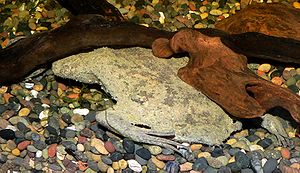Great honeycomb toad
| Great honeycomb toad | ||||||||||||
|---|---|---|---|---|---|---|---|---|---|---|---|---|

Great comb toad ( Pipa pipa ), in the center of the picture in gray |
||||||||||||
| Systematics | ||||||||||||
|
||||||||||||
| Scientific name | ||||||||||||
| Pipa pipa | ||||||||||||
| ( Linnaeus , 1758) |
The great comb toad ( Pipa pipa ), also known as the Amazon comb toad , is a South American frog from the tongueless family .
features
Females of the Great Honeycomb Toad grow to around 17 cm long, while males stay shorter with a maximum of 15 cm. She has a broad and flattened physique, and an equally flat, triangular head with tiny, lidless, black eyes. The skin is wrinkled, rough, brown to gray in color and provided with dark spots; the underside is lighter in color. The hind legs are large and fin-like. The fingers of the front legs end in star-shaped, four-pointed tips.
Females can only be distinguished morphologically from males during the mating season. Then they have a ring-shaped swelling on their cloaca .
distribution and habitat
This species lives year-round in an aquatic environment in cloudy, slow-flowing waters, as well as in pools or swamps in eastern South America. It is also common in Trinidad and always lives below an altitude of 400 meters. In the red list of endangered species , the great comb toad is listed as not endangered (“least concern”). They usually hide under leaf litter in their habitat, and they rarely go ashore.
The honeycomb toad feeds omnivorously. They mainly eat worms, insects, crustaceans and small fish. Since they have no tongue, they search the bottom for food with the fingers of their front legs. Juveniles eat invertebrates such as daphnia or species of Tubifex .
Reproduction
As a mating call, the male utters series of rapid clicks. Males and females then perform a “mating dance” underwater by swimming upside down loops while being inguinally gripped . In the top phase of a loop, the female sheds three to ten eggs while the male sheds his sperm at the same time . The pair then dives back down and here the sinking eggs land on the female's back and stick there. The male supports this process by pressing the eggs against the skin of the back with the help of his hind feet. This ritual is performed up to 18 times, and a total of up to 100 eggs can be laid and fertilized.
In the hours after fertilization, the eggs sink into the female's skin and are overgrown by skin, which develops into a kind of horny lid. As they develop in the eggs, the young grow a temporary tail. After 12 to 20 weeks, fully developed young toads hatch from the honeycomb on the back, so no free larval stages are passed through.
Individual evidence
- ↑ a b c d e Pipa pipa. In: Animal Diversity Web. University of Michigan, accessed May 6, 2013 .
- ↑ Pipa pipa in the endangered Red List species the IUCN 2012. Posted by: Enrique La Marca, Claudia Azevedo-Ramos, Débora Silvano, Luis A. Coloma, Santiago Ron, Jerry Hardy, Manfred Beier, 2010. Retrieved on May 6, 2013 .
